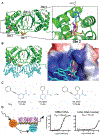Structure-based design of small-molecule inhibitors of EBNA1 DNA binding blocks Epstein-Barr virus latent infection and tumor growth
- PMID: 30842315
- PMCID: PMC6936217
- DOI: 10.1126/scitranslmed.aau5612
Structure-based design of small-molecule inhibitors of EBNA1 DNA binding blocks Epstein-Barr virus latent infection and tumor growth
Abstract
Epstein-Barr virus (EBV) is a DNA tumor virus responsible for 1 to 2% of human cancers including subtypes of Burkitt's lymphoma, Hodgkin's lymphoma, gastric carcinoma, and nasopharyngeal carcinoma (NPC). Persistent latent infection drives EBV-associated tumorigenesis. Epstein-Barr nuclear antigen 1 (EBNA1) is the only viral protein consistently expressed in all EBV-associated tumors and is therefore an attractive target for therapeutic intervention. It is a multifunctional DNA binding protein critical for viral replication, genome maintenance, viral gene expression, and host cell survival. Using a fragment-based approach and x-ray crystallography, we identify a 2,3-disubstituted benzoic acid series that selectively inhibits the DNA binding activity of EBNA1. We characterize these inhibitors biochemically and in cell-based assays, including chromatin immunoprecipitation and DNA replication assays. In addition, we demonstrate the potency of EBNA1 inhibitors to suppress tumor growth in several EBV-dependent xenograft models, including patient-derived xenografts for NPC. These inhibitors selectively block EBV gene transcription and alter the cellular transforming growth factor-β (TGF-β) signaling pathway in NPC tumor xenografts. These EBNA1-specific inhibitors show favorable pharmacological properties and have the potential to be further developed for the treatment of EBV-associated malignancies.
Copyright © 2019 The Authors, some rights reserved; exclusive licensee American Association for the Advancement of Science. No claim to original U.S. Government Works.
Conflict of interest statement
Figures







Comment in
-
New Agents Designed to Fight EBV+ Cancers.Cancer Discov. 2019 May;9(5):OF1. doi: 10.1158/2159-8290.CD-NB2019-040. Epub 2019 Mar 27. Cancer Discov. 2019. PMID: 30917998
References
-
- Parkin DM, Global cancer statistics in the year 2000. Lancet Oncol. 2, 533–543 (2001). - PubMed
-
- Young LS, Yap LF, Murray PG, Epstein–Barr virus: More than 50 years old and still providing surprises. Nat. Rev. Cancer 16, 789–802 (2016). - PubMed
-
- Young LS, Rickinson AB, Epstein–Barr virus: 40 years on. Nat. Rev. Cancer 4, 757–768 (2004). - PubMed
-
- Farrell PJ, Epstein–Barr virus and cancer. Annu. Rev. Pathol 24, 29–53 (2019). - PubMed
Publication types
MeSH terms
Substances
Grants and funding
LinkOut - more resources
Full Text Sources
Other Literature Sources

